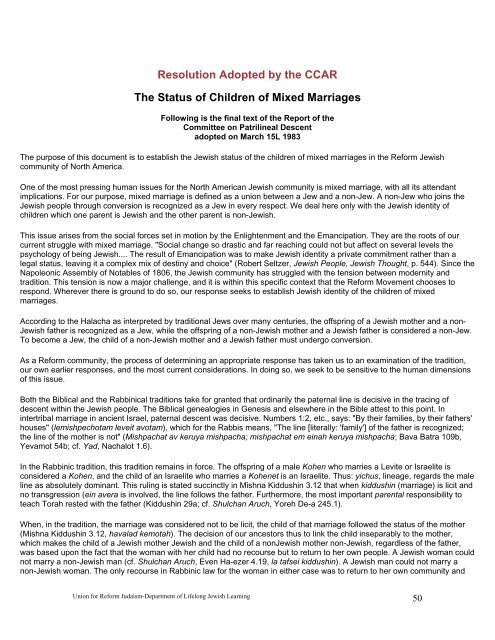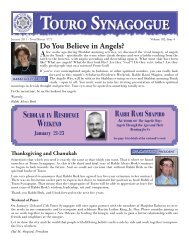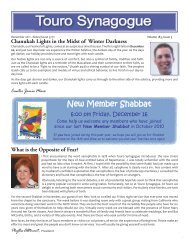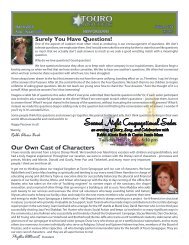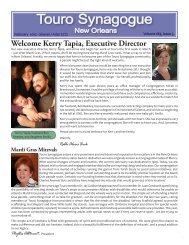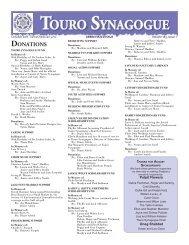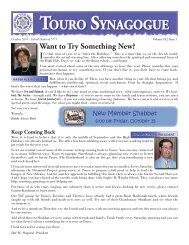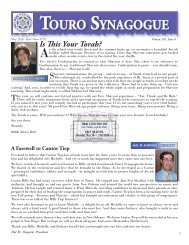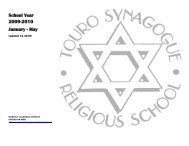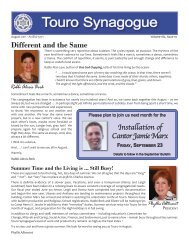Reform Judaism for Teachers module - Touro Synagogue
Reform Judaism for Teachers module - Touro Synagogue
Reform Judaism for Teachers module - Touro Synagogue
You also want an ePaper? Increase the reach of your titles
YUMPU automatically turns print PDFs into web optimized ePapers that Google loves.
Resolution Adopted by the CCAR<br />
The Status of Children of Mixed Marriages<br />
Following is the final text of the Report of the<br />
Committee on Patrilineal Descent<br />
adopted on March 15L 1983<br />
The purpose of this document is to establish the Jewish status of the children of mixed marriages in the <strong>Re<strong>for</strong>m</strong> Jewish<br />
community of North America.<br />
One of the most pressing human issues <strong>for</strong> the North American Jewish community is mixed marriage, with all its attendant<br />
implications. For our purpose, mixed marriage is defined as a union between a Jew and a non-Jew. A non-Jew who joins the<br />
Jewish people through conversion is recognized as a Jew in every respect. We deal here only with the Jewish identity of<br />
children which one parent is Jewish and the other parent is non-Jewish.<br />
This issue arises from the social <strong>for</strong>ces set in motion by the Enlightenment and the Emancipation. They are the roots of our<br />
current struggle with mixed marriage. "Social change so drastic and far reaching could not but affect on several levels the<br />
psychology of being Jewish.... The result of Emancipation was to make Jewish identity a private commitment rather than a<br />
legal status, leaving it a complex mix of destiny and choice" (Robert Seltzer, Jewish People, Jewish Thought, p. 544). Since the<br />
Napoleonic Assembly of Notables of 1806, the Jewish community has struggled with the tension between modernity and<br />
tradition. This tension is now a major challenge, and it is within this specific context that the <strong>Re<strong>for</strong>m</strong> Movement chooses to<br />
respond. Wherever there is ground to do so, our response seeks to establish Jewish identity of the children of mixed<br />
marriages.<br />
According to the Halacha as interpreted by traditional Jews over many centuries, the offspring of a Jewish mother and a non-<br />
Jewish father is recognized as a Jew, while the offspring of a non-Jewish mother and a Jewish father is considered a non-Jew.<br />
To become a Jew, the child of a non-Jewish mother and a Jewish father must undergo conversion.<br />
As a <strong>Re<strong>for</strong>m</strong> community, the process of determining an appropriate response has taken us to an examination of the tradition,<br />
our own earlier responses, and the most current considerations. In doing so, we seek to be sensitive to the human dimensions<br />
of this issue.<br />
Both the Biblical and the Rabbinical traditions take <strong>for</strong> granted that ordinarily the paternal line is decisive in the tracing of<br />
descent within the Jewish people. The Biblical genealogies in Genesis and elsewhere in the Bible attest to this point. In<br />
intertribal marriage in ancient Israel, paternal descent was decisive. Numbers 1:2, etc., says: "By their families, by their fathers'<br />
houses" (lemishpechotam leveit avotam), which <strong>for</strong> the Rabbis means, "The line [literally: 'family'] of the father is recognized;<br />
the line of the mother is not" (Mishpachat av keruya mishpacha; mishpachat em einah keruya mishpacha; Bava Batra 109b,<br />
Yevamot 54b; cf. Yad, Nachalot 1.6).<br />
In the Rabbinic tradition, this tradition remains in <strong>for</strong>ce. The offspring of a male Kohen who marries a Levite or Israelite is<br />
considered a Kohen, and the child of an Israelite who marries a Kohenet is an Israelite. Thus: yichus, lineage, regards the male<br />
line as absolutely dominant. This ruling is stated succinctly in Mishna Kiddushin 3.12 that when kiddushin (marriage) is licit and<br />
no transgression (ein avera is involved, the line follows the father. Furthermore, the most important parental responsibility to<br />
teach Torah rested with the father (Kiddushin 29a; cf. Shulchan Aruch, Yoreh De-a 245.1).<br />
When, in the tradition, the marriage was considered not to be licit, the child of that marriage followed the status of the mother<br />
(Mishna Kiddushin 3.12, havalad kemotah). The decision of our ancestors thus to link the child inseparably to the mother,<br />
which makes the child of a Jewish mother Jewish and the child of a nonJewish mother non-Jewish, regardless of the father,<br />
was based upon the fact that the woman with her child had no recourse but to return to her own people. A Jewish woman could<br />
not marry a non-Jewish man (cf. Shulchan Aruch, Even Ha-ezer 4.19, la tafsei kiddushin). A Jewish man could not marry a<br />
non-Jewish woman. The only recourse in Rabbinic law <strong>for</strong> the woman in either case was to return to her own community and<br />
Union <strong>for</strong> <strong>Re<strong>for</strong>m</strong> <strong>Judaism</strong>-Department of Lifelong Jewish Learning<br />
50


